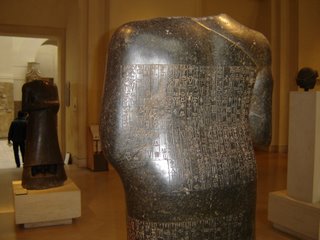


During a recent visit to the Louvre, a friend and I came
 across a room full of these wonderful Sumerian statues. They are of Gudea, prince of Lagash, dating from roughly 2120 BC. The statues are of diorite stone and all housed in one room on the ground floor (Richelieu, Mesopotamia, room 2).
across a room full of these wonderful Sumerian statues. They are of Gudea, prince of Lagash, dating from roughly 2120 BC. The statues are of diorite stone and all housed in one room on the ground floor (Richelieu, Mesopotamia, room 2).What caught my eye about these statues, most of which are dedicated to Sumerian gods such as Ningirsu and Ba'u, is the fact that they are covered in writing. The Accadian inscriptions seem to be part of the statues, and not captions or labels. Text is integrated into the visual representation of the Prince's body, with panels of text appearing on the royal costume on backs, wrapped around shoulders, on arms and legs, hands, necks, in some cases covering nearly the whole body.
The statue called 'The Architect's Plan' (bottom right and top left) shows the Prince of Gudea as a royal builder, seated with a plan of a temple on his lap. The text draped down over the Prince's gown and chair celebrates and dedicates the project of construction: ''For my Lord I have built a temple, that life be my reward....to perpetuate the prince's prayer before the divinities of the city."
The scripted text is so striking and central to the piece that it thwarts any modern tendency to separate the verbal and the visual. This is multimodal statuary, drawing on both word and image to convey an effect.
"Gudea confers on the statue the gift of speech...."
After this, elsewhere in the Louvre I kept noticing the separation of word and image in the art of later periods. Words move to the side or to the foot of the artifact - as captions, as notes, as labels. The pointing role of writing - writing as reference - takes over. Visual and verbal representation set out on their individual paths towards our kept-apart notions of 'Literature' and 'Visual Art', towards the assumption that 'writing' somehow excludes image, even though it is palpably visual and spatial.
In these ancient statues the visual and the verbal are combined in a way that asks us to attempt to unlearn this distinction, to recover a world where image and script are intimately combined.






No comments:
Post a Comment